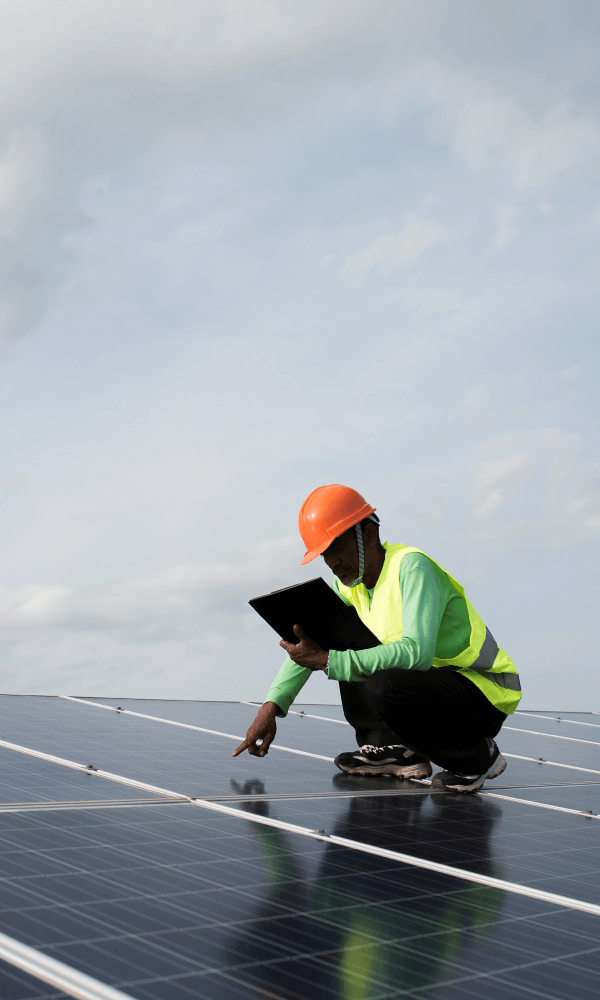Solar Industry Research Growing at a Record Pace
Solar energy in the United States is booming. Along with our partners at Wood Mackenzie Power & Renewables, SEIA tracks trends and trajectories in the solar industry that demonstrate the diverse and sustained growth of solar across the country.
Below you will find charts and information summarizing the state of solar in the U.S. If you’re looking for more data, explore our resources page. In addition, SEIA Members have access to presentation slide decks that contain this data and much more. Not a SEIA Member? Join today!
The Past Ten Years have Set the Stage for the Solar+ Decade
Solar has seen massive growth since 2000. There are now over 219 gigawatts (GW) of solar capacity installed nationwide, enough to power over 37 million homes. In the last decade, solar deployments have experienced an average annual growth rate of 26%. Strong federal policies like the solar Investment Tax Credit (ITC), rapidly declining installation costs, and increasing demand for clean electricity across the private and public sector have driven this growth.
Solar as an Economic Engine
As of 2023, nearly 280,000 Americans work in solar at more than 10,000 companies in every U.S. state. In 2023, the solar industry generated over $60 billion of private investment in the American economy.
Growth in Solar is Led by Falling Prices
The cost to install solar has dropped by nearly 40% over the last decade, leading the industry to expand into new markets and deploy thousands of systems nationwide. An average-sized residential system has dropped from a pre-incentive price of $40,000 in 2010 to roughly $25,000 today, while recent utility-scale prices range from $16/MWh – $35/MWh, competitive with all other forms of generation.
Inflation, Supply Chain Constraints Lead to Price Volatility
Over the past 20 years, solar prices have declined dramatically. However, the last 3 years have been volatile for solar pricing. Inflation and supply chain challenges stemming from the global pandemic and trade instability contributed to price increases. Supply chain disruptions have eased, and U.S. manufacturing has ramped up, making modules more widely available and easing pressure on prices. Year-over-year module prices continued to fall for all segments in Q3. However, increased labor and overhead costs in the utility-scale segment cut into these declines, keeping year-over-year prices elevated in Q3.
Solar’s Share of New Capacity has Grown Rapidly
Solar was the predominant new generating capacity to the grid each of the last three years and that the same is expected in 2024. 55% of all new electric capacity added to the grid in 2023 came from solar, marking the first time in 80 years a renewable energy resource has captured a majority of new capacity added. The industry continued to lead the energy transition through Q3, representing over 64% of new capacity. Solar’s increasing competitiveness against other technologies has allowed it to quickly increase its share of total U.S. electrical generation – from just 0.1% in 2010 to over 6% today.
The U.S Solar Industry is a 50-State Market
Historically, California been the largest state solar market though other markets are continuing to expand rapidly. Texas led all states in new installations in Q3 2024 with 2.4 GW of new installed capacity. In addition, Puerto Rico and 31 U.S. states have installed a cumulative 1 GW or more of solar, compared to only 3 states a decade ago. As demand for solar continues to grow, new state entrants will capture an increasing share of the national market.
High Soft Costs Cut Into Residential Price Declines
While residential hardware costs have varied over the past 10 years, soft costs (SG&A, permitting, inspection, interconnection and labor) have remained stubbornly high and have even increased, pushing the soft cost share to its highest point in years. U.S. solar soft costs continue to be much higher than those of other developed solar markets around the world. Through programs like Solar Automated Permit Processing (SolarAPP) and SolSmart, SEIA and our partners are working to reduce local barriers to going solar.
Storage is Increasingly Paired with All Forms of Solar
Homeowners and businesses are increasingly demanding solar systems that are paired with battery storage. California’s shift in net metering policy and state incentives for solar+storage in other markets have driven attachment rates up in recent quarters. By 2028, 28% of all new distributed solar capacity will be paired with storage, compared to under 12% in 2023. The utility-scale market is also recognizing the benefits of pairing solar with storage, with 3 GW of new storage systems deployed alongside solar in 2023, more than double the capacity deployed in 2022.
Residential Market Continues to Diversify
1.1 GW of residential solar were installed in Q3 2024, marking a 4% decline quarter-over-quarter. High household electricity bills and power outages have driven demand, as have changes to California’s Net Metering rules. Customers in California rushed to sign up for projects under the old, more favorable rules before they expired in Spring 2023, and build out of that pipeline propped up national installation volumes in 2023. Thus far in 2024 however, the depletion of the California queue coupled with higher financing costs across all states has hurt the segment, which saw its lowest quarter for new installations since 2021. 2024 will be a down year for residential solar, but emergent state markets will drive growth in the second half of the 2020s.
Tax Credits Help Drive Emerging Commercial Markets
The commercial solar market, which consists of on-site solar installations for businesses, non-profits and governments, has historically been dominated by a handful of markets: California, Massachusetts, New Jersey and New York. Because of their outsized portion of the market, policy and incentive changes in any of those states could rattle the market and stymie national growth. However, federal tax credits will lead to growth in emerging commercial markets through provisions on transferability, direct pay, and the various adder credits.
Community Solar Expansion
While early growth for community solar installations was led primarily by three key markets – New York, Minnesota, and Massachusetts – a growing list of states with community solar programs have helped diversify the market. Maine and Illinois continued build out of extensive community solar pipelines in 2023, while markets in Maryland and New Jersey saw large improvements from 2022. As more states and utilities create and expand community solar programs, access to solar will expand to all types of households and businesses.
Utility-Scale Segment Rebounds from Supply Challenges
Supply chain challenges stemming from trade action stymied utility-scale installations in 2022. As module supply improved throughout 2023, many delayed projects were finally brought online, along with large portions of the previously existing 2023 pipeline. In 2023, over 30 GW of new utility-scale projects had been installed, more than doubling 2022 volumes. The utility scale segment has continued to deploy at a record pace in 2024, outpacing new contracts. Going forward, demand from states, utilities, and corporations with increasing energy demand remains high and continues to drive growth in the segment.
Solar PV Growth Forecast
Over 30 GW have been installed through Q3 of 2024, as solar has become the dominant technology for new capacity in the U.S. Installations are expected to hold steady around 40-45 GW annually over the next five years. The Inflation Reduction Act has made these installation volumes possible by providing key tax credits that provide long-term certainty. Challenges in interconnection, high voltage power equipment procurement, and labor availability present the biggest headwinds to faster growth.
Federal Incentives Fuel Market Growth
The passage of the Inflation Reduction Act has drastically improved baseline projections for the solar industry over the next five years. In the next half decade, the long-term tax incentives and manufacturing provisions in the IRA provide the market certainty needed to boost expected solar deployment by 46% compared to pre-IRA projections.
New Manufacturing for a Secure Supply Chain
In addition to spurring deployment of solar energy, the IRA created increased interest in U.S. solar and storage manufacturing. Over 24 GW of new U.S. module manufacturing capacity came online in 2024. As the industry faces uncertainty as a result of new trade action, U.S. solar manufacturing will be help ease the supply challenges that have hampered the industry in years past. Investment in battery storage manufacturing has been announced, and these manufacturing facilities will ensure that the solar and storage industries have access to reliable, domestic supply for future growth.
More Aggressive Growth Needed to Reach Climate Goals
While projected growth over the next 10 years puts the solar market on a growth path, more work is needed to achieve the pace required for a 100% clean energy electricity system. Annual installations will need to grow to nearly 140 GW by 2030, with cumulative totals over 800 GW by the end of the decade to meet the goal of 100% carbon free electricity by 2035. A combination of private sector innovation and stable, long-term public policy will set the solar industry on a path to achieving these more aggressive goals to address climate change and decarbonize the economy.
Companies Procure Record Levels of Solar and Storage
Data from SEIA’s annual Solar Means Business report show that major U.S. corporations, including Meta, Amazon, Google, Apple, and Walmart are investing in solar and storage at record levels. Through Q1 2024, the top corporate solar users in America have installed nearly 40 GW of solar capacity, along with over 1.8 GWh of battery storage.
Other key takeaways:
- Over 18% of U.S. solar capacity has a corporate offtaker
- Companies are increasingly diversifying their procurement strategies, including through both on-site and off-site solar, as well as community solar, green tariffs, and solar + storage
- Amazon, Google, and Meta have a combined contracted pipeline of over 25 GW
You can explore SEIA’s Solar Means Business report, view additional data and read market sentiment analysis of the corporate solar space.



